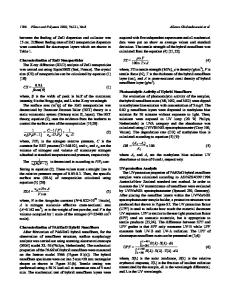A Novel Polyamide 12/Al-Cu-Fe Quasicrystal Composite
- PDF / 417,183 Bytes
- 6 Pages / 612 x 792 pts (letter) Page_size
- 103 Downloads / 275 Views
A Novel Polyamide 12/Al-Cu-Fe Quasicrystal Composite Yuejian Liu, Paul D. Bloom1, Valerie V. Sheares1 and Joshua U. Otaigbe Department of Materials Science and Engineering, 1 Department of Chemistry, Iowa State University, Ames, IA 50011, U.S.A. ABSTRACT The tribological and mechanical properties of a novel polyamide 12 (PA12)/Al-Cu-Fe quasicrystal (QC) composite were systematically studied to accelerate efforts to develop a useful, melt-processable, and wear-resistant polymer composite. The wear and friction properties were characterized using a pin-on-disk configuration and the static and dynamic mechanical properties were investigated using dynamical mechanical analyzer, tensile tester, and an impact tester. Further, the melt processability of the composite was studied using a Haake torque rheometer and a dynamic rotational rheometer. The results suggest that PA12/QC composite can be meltprocessed into a wear-resistant material with enhanced mechanical properties for applications where combinations of wear resistance and good mechanical properties are required. The static mechanical properties of the composite were found to be consistent with the Halpin-Tsai equation and agreement was observed between the measured viscoelastic properties and theoretical predictions of Burgers’ and Eilers’ models. INTRODUCTION Quasicrystals are new materials with many excellent qualities. Al-Cu-Fe quasicrystals are noteworthy for their hardness, low thermal conductivity, low surface energy, and low friction. Polymer/quasicrystal composites represent one promising application of quasicrystals. Polyphenylene sulfide (PPS), poly (aryletherketone) (PAEK) and poly (etherketoneketone) (PEKK) have been investigated as matrices of polymer/Al-Cu-Fe quasicrystal composites [1-4]. It was discovered that quasicrystal Al-Cu-Fe particles enhanced the wear resistance of the polymers significantly. Because of their high melt viscosity, it is very difficult to melt process the high performance thermoplastics with quasicrystals using conventional polymer processing techniques such as injection molding or extrusion. Therefore, low melt viscosity PA12 was studied as a potential matrix of the composite in this paper. It is expected that a high amount of quasicrystalline Al-Cu-Fe particles may be incorporated with PA12, allowing the application of conventional polymer processing methods (injection molding, extrusion, etc.) to form and shape the composite. EXPERIMENTAL The quasicrystal used in this study was icosahedral Al-Cu-Fe (i-Al-Cu-Fe) phase rich powder with the composition Al65Cu23Fe12. QC powder in spherical particles with diameter 5375 um was provided by Ames Laboratory of the U.S. Department of Energy. The powder was produced by gas atomization with an approximate composition of 60% icosahedral phase and 40% cubic phase. PA12 (trademark VESTAMID L1700) was supplied by Creanova Inc (Huls). Polystyrene (PS) (trademark STYRON 666D, injection grade) was supplied by Dow Chemical Company. U9.5.1
The composites were prepared according to the follow
Data Loading...











